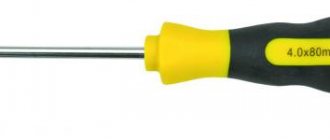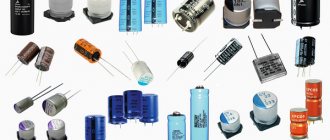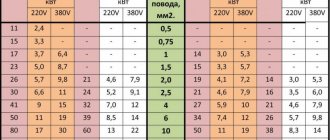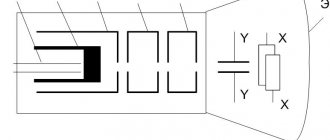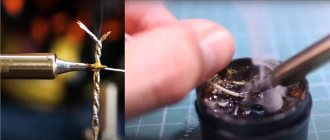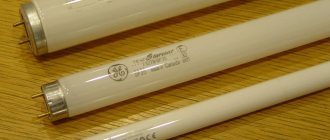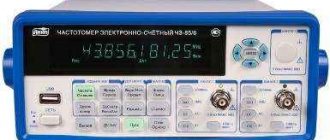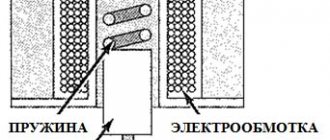Parameters of Phillips screwdrivers
Many craftsmen use automatic devices in their households. But this is just a technological trend of the times that will not replace the use of a conventional screwdriver, which requires mechanical action and some physical effort.
Without the help of tools, the screws cannot be tightened with sufficient force.
The popularity of Phillips screwdrivers is explained by their wide range of applications. They have a specialized designation in the form of a cross and the letters RN. They are considered indicators of the size of the tool. The minimum one is marked “000”. This means that with such a screwdriver you can screw fasteners up to 1.5 mm.
Approximate markings and their meanings:
- 00 - 1.5-1.9 mm;
- 0 - 2 mm;
- 1 - 2.1-3 mm;
- 2 - 3.1-5 mm;
- 3 - 5.1-7 mm;
- 4 - more than 7.1 mm.
developed the PZ slot.
The marking indicates not only the size of the tip, but also the thickness of the rod.
The length of the handle should be selected depending on the space in which the work will take place. So, if installation takes place in a narrow room, it is recommended to choose a model with a short handle. If it is difficult to get to the fastening point, you should choose a tool with a rod length of 300 mm.
The value of RN stands for the name. It happens that instruments are marked PZ, which stands for “Pozydrive”.
invented the PH slot
The tool with the latest marking has an additional beam that provides a stronger hold when fastening. It allows you to fasten cabinet furniture, drywall and aluminum profiles during assembly.
When choosing, consider the rod strength. By standards, it has an indicator of 47-52 units. If the number is less, the tip will bend, and if it is more, it will break.
For your information! Most often, the strength indicator is denoted by the letters Cr-V.
Main types of screwdrivers
For a long time, two types of screwdrivers were used to loosen and tighten fasteners. They are still in use in all spheres of human activity. But, besides them, other types of tools have appeared that make work easier. Their classification is related to the structure of the sting.
Straight slot tool
The main advantage of this device is its ability to be used for many tasks. A slotted screwdriver, the dimensions of which correspond to the size of the fastener, can be used anywhere. With this tool you can open a lock, configure elements of an electronic circuit, and use it in debugging mechanical devices.
When unscrewing, you do not need to press hard on the tool. The tip itself is fixed in the slot and does not jump out if the gap between them is minimal. A well-fitted handle provides good torque, which can be enhanced with a hex rod using a wrench.
What are the differences between a Phillips and a flathead screwdriver?
A Phillips screwdriver is the most popular tool for repairs.
Range and features of use:
- They vary in tip diameter.
- Suitable for most types of screws, screws and self-tapping screws.
- To facilitate operation, the tip of the tool is supplemented with a magnet.
One of the most popular models.
Next, the specifics and features of using a flat or slotted screwdriver are discussed. The blade of a flat-head screwdriver is made of a narrow plate.
Previously, the majority of fasteners were made with a straight tip line. In this case, it is necessary to select a tip of the required length.
Today, such fasteners are used less frequently, and their installation is carried out only with the flat end of a screwdriver. Cross versions of the tool make it possible to install and detach shaped fasteners.
Magnetic models have a stronger tip
The tip of this screwdriver has a large number of projections, which allows for a tight grip on the parts being unscrewed. Cross models allow you to work with household items, wood and metal. Flathead screwdrivers are more used for fastening door handles, sockets and other small elements.
Features of using a flat-tip screwdriver:
- Suitable for screwing in and out screws.
- Used less frequently than the cross "colleague".
- The length of the tip is measured in millimeters.
Note! Screwdrivers also differ in the shape of the tip that is selected. It all depends on the purpose of use. In addition, the sizes of flathead and Phillips screwdrivers differ. The parameter is selected depending on the diameter of the screw.
You may be interested in this Features of voltage measuring instruments
Special devices
In addition to the two main ones, there are also types of screwdrivers whose names are little known to a wide range of users. They are designed to perform special operations. Such shaped screwdrivers are not produced in large quantities, but they are worthy of mention:
- A variant of the Phillips screwdriver is a tool with a Torx slot. It provides even greater fixation force for the fastener. Often used in complex electronic devices to prevent opening the case by unqualified personnel.
- For the most part, screwdrivers of the Torq - Set variety are used in the production of aviation equipment. Characterized by maximum torque.
- They also use a device in the form of a Tri-Wing trefoil.
- For devices with anti-vandal protection, a screwdriver is used - a spanner with two pins.
- In electrical engineering, a probe screwdriver is used to determine phasing. With their help, you can find the positive and negative contacts in devices powered by a DC source.
- A screwdriver with a flexible shaft is indispensable for use in hard-to-reach places.
There are also tools with handles made of special material for use in aggressive environments and sets consisting of a shaft - ratchet with a set of interchangeable heads with splines of various types.
What does a screwdriver consist of?
As a rule, a screwdriver is made of 3 main components: a tip, a rod and a handle. The shape of the tip depends on the brand of the fastener.
A fastening element is considered to be:
- screw;
- screw;
- self-tapping screw
The tool can work with screws, screws and self-tapping screws.
The components of the tool and the quality of their workmanship affect its final use.
Features, sizes and where to use
Pz is used mainly in furniture assembly and construction.
It is not as common in machine manufacturing or metalworking. This is explained by the fact that due to the greater depth, the posidrive fasteners must have slightly larger heads. Otherwise, their strength decreases and they break off.
Well, a larger size always means more weight, which is often unacceptable in some critical industries.
Moreover, both splines have 5 main dimensions, rigidly tied to the diameter of the fastener.
The most common numbers are 1, 2 and 3. Both Ph and Pz.
The most popular of them is the Pz2. It’s not for nothing that in sets of bits, this size is usually included in 2 pieces. It is used most often and, as a result, wears out most often.
Walking into a hardware store, a knowledgeable buyer immediately tells the sales consultants: “I’d like a set of two Pozidrive bits, please.”
Amateurs and non-professionals usually call them “double plus”! Be literate in such seemingly small but important issues.
However, the correct name is not the key to success. Having the same names, bits from different manufacturers may differ.
The highest quality brands are Wiha, Wera, Milwaukee.
If with the Ph profile everything is still more or less smooth and not everyone can mess up, then with the Pz profile a real disaster happens. Chinese bit manufacturers simply do not follow the sizes and standards.
So it turns out that some bits are thicker, others thinner. The same goes for fasteners. Unfinished notches in the head of a screw or self-tapping screw are completely commonplace. As a rule, this is observed in the smallest sizes up to 20mm for Pz1, Pz2 and Ph1 bits.
In this type of fastener, the tip of the bit already rests against the notch, but there is no edge of the bit yet. As a result, the screw begins to dangle like a metronome. Therefore, when purchasing in bulk from a store, it is advisable to immediately try on the bit with the fastener head.
Subtleties of operation
The ingenuity of a modern person quite often exceeds all expectations. Objects and tools intended for the same purposes are used in a completely opposite profile. For example, with the help of a screwdriver, many people scrape off various types of dirt from different surfaces, separate stuck parts, and even use it along with a chisel.
All these actions contradict the natural operation of the screwdriver; accordingly, the tool quickly becomes unusable. All that remains is to make a choice between buying a new one and tidying up the old instrument.
Everyone can repair the handle of a screwdriver, but not everyone can sharpen a damaged blade. Many people try to carry out rescue work correctly, but the result is not always successful.
Sharpening a screwdriver is not an easy task, much like the principle of sharpening a blade on skates. Only with cross models you should be extremely careful. Initially, the metal is heated until reddened, then it is dipped in a lubricating fluid, then it cools a little and sharpening begins. The complexity of this procedure lies in the small size of the tip rays and the inconvenience of approaching them.
After sharpening, the treated tool should be magnetized. To do this, place a screwdriver next to the magnet and leave it for a while.
How to sharpen a Phillips screwdriver, see the video below.
Varieties
Today there are dozens of types of screwdrivers. However, the most common types are the flathead screwdriver and the Phillips slotted screwdriver. On their basis, other types of this tool are developed and created. Let's take a closer look at them.
Flat head screwdriver
The very first type of tools with a flat slot has been known since the 15th century. It has been preserved with certain changes to this day. Due to its versatility, it can be used for various types of fasteners, including screws. The flat one holds perfectly in the groove and allows you to create good torque without any problems. The flat design is also distinguished by the following characteristics:
- In addition to standard use, they are well used in tuning electrical circuits; they allow you to open locks with slotted grooves;
- Flat slots are found on many tools, such as plates and knives. This means that a screw that is not too tight can be unscrewed using the specified tools;
- Such accessories are good to use for finishing work, including spring mechanisms.
At the same time, there is one serious drawback - weak stability. A small lateral force is enough and it will slide out of the groove. Fixation in only one plane does not prevent the slot from sliding along the entire screw.
Phillips screwdriver
It is a modernized version of the flat design. The goal was to eliminate the disadvantages of the flat spline. The latter tried to jump out of the groove, and when the screw was tightened all the way, the head could break.
The solution was found by Phillips, who developed the slot described above. Due to this, a slight vertical deviation will not lead to the tool being pulled out. Side shift stops securely hold the spline in the fastener. The convenience was immediately appreciated by joiners and carpenters
This was especially important when screwing screws into wooden structures. Productivity has increased almost several times
However, they also have disadvantages:
- Great effort is required to operate the tool. This leads to rapid wear of the cross splines;
- A constant force must be applied to keep the tool in the desired plane. As a result, the employee gets tired quickly;
- The cross is limited in size. Very small ones with a similar slot are not produced, since they will not be in demand.
Despite these disadvantages, the Phillips slot has gained considerable popularity among representatives of blue-collar professions. 75 percent of fasteners are manufactured specifically for this modification.
Recently, an improved version of the Phillips slot has been developed called Torx. He is not afraid of strong fixation. Allows you to effectively protect complex products from unauthorized repairs. A production with replaceable cross heads, called bits, has also been launched. Such tools should be in every household of an experienced craftsman.
